Soil Moisture and Nutrient Changes of Agroforestry in Karst Plateau Mountain: A Monitoring Example
Abstract
1. Introduction
2. Materials and Methods
2.1. Study Area
2.2. Experimental Design
2.3. Sample Analysis
2.4. Data Analysis
3. Results
3.1. Differences in Soil Nutrient Content
3.2. Soil Permeability and Porosity
3.3. Soil Moisture Content and Precipitation
4. Discussion
4.1. Soil Response to Precipitation
4.2. Soil Moisture Was Affected by Precipitation, Soil Porosity, and Permeability
4.3. Soil Moisture Content Fluctuated Seasonally
4.4. Topographic Environment Is an Important Factor Affecting the Difference of Soil Moisture Content
4.5. The Composition of Agroforestry Is an Important Factor Affecting the Change of Soil Moisture Content
5. Conclusions
Author Contributions
Funding
Data Availability Statement
Conflicts of Interest
References
- Yuan, D.X.; Jiang, Y.J.; Shen, L.C.; Pu, J.B.; Xiao, Q. Modern Karst; Science Press: Beijing, China, 2016. [Google Scholar]
- Xiong, K.N. The Midas Touch-Technology and Model of Rocky Desertifification Control in Guizhou Province; Guizhou Science and Technology Press: Guiyang, China, 2011; pp. 14–22. [Google Scholar]
- Wu, Z.G.; Zhu, D.Y.; Xiong, K.N.; Wang, X.F. Dynamics of landscape ecological quality based on benefit evaluation coupled with the rocky desertification control in South China Karst. Ecol. Indic. 2022, 138, 108870. [Google Scholar] [CrossRef]
- Chen, H.S.; Fu, Z.Y.; Zhang, W.; Nie, Y.P. Soil water processes and vegetation restoration of southwest china. Nat. Mag. 2018, 41, 41–46. [Google Scholar]
- Lu, M.; Liu, K.; Zhang, L.; Zeng, F.; Song, T.; Peng, W.; Du, H. Stoichiometric Variation in Soil Carbon, Nitrogen, and Phosphorus Following Cropland Conversion to Forest in Southwest China. Forests 2022, 13, 1155. [Google Scholar] [CrossRef]
- Liu, Z.; She, R.; Xiong, K.; Li, Y.; Cai, L. Effect of Vegetation Restoration on Soil Hydrology in Karst Area of Southwest China: Inspiration from Barrel Planting Experiments. Water 2021, 13, 1719. [Google Scholar] [CrossRef]
- Bronstert, A. Capabilities and limitations of detailed hillslope hydrological modelling. Hydrol. Process. 1999, 13, 21–48. [Google Scholar] [CrossRef]
- Rodriguez-Iturbe, I.; Porporato, A.; Laio, F.; Ridolfi, L. Plants in water-controlled ecosystems: Active role in hydrologic processes and response to water stress. I. Scope and general outline. Adv. Water Res. 2001, 24, 695–705. [Google Scholar] [CrossRef]
- Qin, H.J. Influence of Under-Forest Economic Models on Vegetation and Soil in Karst Mountain in Southwest China; Southwest University: Chongqing, China, 2014. [Google Scholar]
- Jing, J.S. Hydological Process of Karst Fissures and Resistance and Control Technology of Soil and Water Loss in Agroforestry; Guizhou Normal University: Guiyang, China, 2021. [Google Scholar] [CrossRef]
- Jing, J.S.; Liu, Z.Q.; Li, Y.; Wang, J.; Luo, D.; Cai, L.L. Vegetation Types Affect Responsive Change in Soil Moisture to Rainfall in under Karst Rocky Desertification Control Areas. J. Irrig. Drain. 2020, 39, 100–109. [Google Scholar] [CrossRef]
- She, R.; Liu, Z.Q.; Li, Y.; Cai, L.L. Response of soil moisture to rainfall in different vegetation types in typical rocky desertification area. J. For. Environ. 2021, 41, 478–486. [Google Scholar] [CrossRef]
- Gao, A.J.; Liu, Z.Q.; Li, Y.; Li, K.P. Study on soil moisture variation characteristics of different economic forest lands in karst gorge area: A case study of Huajiang demonstration area in Guizhou Province. Carsologica Sin. 2020, 39, 863–872. [Google Scholar]
- Cai, L.L. Study on Soil Moisture and Nutrient Transport in Typical Karst Fissure; Guizhou Normal University: Guiyang, China, 2021. [Google Scholar] [CrossRef]
- Li, Y.; Yu, Y.; Song, Y. Soil Properties of Different Planting Combinations of Zanthoxylum planispinum var. dintanensis Plantations and Their Effect on Stoichiometry. Agronomy 2022, 12, 2562. [Google Scholar] [CrossRef]
- Xu, Q.; Xiong, K.; Chi, Y. Effects of Intercropping on Fractal Dimension and Physicochemical Properties of Soil in Karst Areas. Forests 2021, 12, 1422. [Google Scholar] [CrossRef]
- Li, W.H. Agroforestry Management in China; Science Press: Beijing, China, 1994. [Google Scholar]
- Cheng, H.; Hu, W.; Zhou, X.; Dong, R.; Liu, G.; Li, Q.; Zhang, X. Fruit Tree Legume Herb Intercropping Orchard System Is an Effective Method to Promote the Sustainability of Systems in a Karst Rocky Desertifification Control Area. Forests 2022, 13, 1536. [Google Scholar] [CrossRef]
- Pellek, R. Contour hedgerows and other soil conservation interventions for hilly terrain. Agrofor. Syst. 1992, 17, 135–152. [Google Scholar] [CrossRef]
- Zhu, X.; Liu, W.; Chen, J.; Bruijnzeel, L.A.; Mao, Z.; Yang, X.; Cardinael, R.; Meng, F.-R.; Sidle, R.C.; Seitz, S.; et al. Adrian Bruijnzeel. Reductions in water, soil and nutrient losses and pesticide pollution in agroforestry practices: A review of evidence and processes. Plant Soil 2019, 453, 45–86. [Google Scholar] [CrossRef]
- Wu, Q.L.; Liang, H.; Xiong, K.N.; Li, R. Eco-benefifits coupling of agroforestry and soil and water conservation under KRD environment: Frontier theories and outlook. Agrofor. Syst. 2019, 93, 1927–1938. [Google Scholar] [CrossRef]
- Xu, Q.; Xiong, K.; Chi, Y.; Song, S. Effects of Crop and Grass Intercropping on the Soil Environment in the Karst Area. Sustainability 2021, 13, 5484. [Google Scholar] [CrossRef]
- Mu, Y.T. Study on Influence Mechanism of Moisture and Carbon/Nitrogen Migration in Soil Interflow under Karst Ecological Restoration Model; Guizhou Normal University: Guiyang, China, 2021. [Google Scholar] [CrossRef]
- Wang, J. Study on Nutrient Loss of Fissure Water and Soil in Karst Rocky Desertification Area; Guizhou Normal University: Guiyang, China, 2020. [Google Scholar] [CrossRef]
- Forest Soil Research Office; Forestry Research Institute; Chinese Academy of Forestry Sciences. Determination of Moisture-Physical Properties of Forest Soil LYT1215-1999; The State Forestry Administration: Beijing, China, 1999; pp. 21–24. [Google Scholar]
- Environmental Protection Department (EPD). Determination of Total Metals of Soil and Sediment by Microwave Digestion Method HJ 832-2017; The Ministry of Ecology and Environment: Beijing, China, 2017. [Google Scholar]
- Zhu, Q.; Nie, X.F.; Zhou, X.B.; Liao, K.H.; Li, H.P. Soil moisture response to rainfall at different topographic positions along a mixed land-use hillslope. Catena 2014, 119, 61–70. [Google Scholar] [CrossRef]
- Peng, X.D.; Dai, Q.H.; Li, C.L.; Yuan, Y.F.; Zhao, L.S. Effect of simulated rainfall intensities and underground pore fissure degrees on soil nutrient loss from slope farmlands in Karst Region. Trans. Chin. Soc. Agric. Eng. 2017, 33, 131–140. [Google Scholar]
- Liu, Z.Q. Study on Hydrological Ecological Function of Forests in Yunnan Plateau; Kunming University of Technology: Kunming, China, 2014. [Google Scholar]
- Zhang, R.F.; Xu, X.L.; Liu, M.X.; Zhang, Y.H.; Xu, C.H.; Yi, R.Z.; Luo, W. Comparing evapotranspiration characteristics and environmental controls for three agroforestry ecosystems in a subtropical humid karst area. J. Hydrol. 2018, 563, 1042–1050. [Google Scholar] [CrossRef]
- Wang, Y.; Dai, Q.; Ding, P.; Li, K.; Yi, X.; He, J.; Peng, X.; Yan, Y.; Zhao, M.; Yang, Y. Rapid Response of Runoff Carrying Nitrogen Loss to Extreme Rainfall in Gentle Slope Farmland in the Karst Area of SW China. Water 2022, 14, 3341. [Google Scholar] [CrossRef]
- Gan, F.L.; He, B.H.; Qin, Z.Y.; Li, W.B. Contribution of bedrock dip angle impact to nitrogen and phosphorus leakage loss under artificial rainfall simulations on slopes parallel to and perpendicular to the bedrock dip in a karst trough valley. Catena 2021, 196, 104884. [Google Scholar] [CrossRef]
- Zhou, Q.W.; Sun, Z.Y.; Liu, X.L.; Wei, X.C.; Peng, Z.; Yue, C.W.; Luo, Y.X. Temporal Soil Moisture Variations in Different Vegetation Cover Types in Karst Areas of Southwest China: A Plot Scale Case Study. Water 2019, 11, 1423. [Google Scholar] [CrossRef]
- Yang, H.; Miao, N.; Li, S.-C.; Ma, R.; Liao, Z.-Y.; Wang, W.-P.; Sun, H.-L. Relationship between stand characteristics and soil properties of two typical forest plantations in the mountainous area of Western Sichuan, China. J. Mt. Sci. 2019, 16, 1816–1832. [Google Scholar] [CrossRef]
- Bai, L.; Kong, X.; Li, H.; Zhu, H.; Wang, C.; Ma, S. Effects of Conservation Tillage on Soil Properties and Maize Yield in Karst Regions, Southwest China. Agriculture 2022, 12, 1449. [Google Scholar] [CrossRef]
- Vilhar, U. Water Regulation Ecosystem Services Following Gap Formation in Fir-Beech Forests in the Dinaric Karst. Forests 2021, 12, 224. [Google Scholar] [CrossRef]
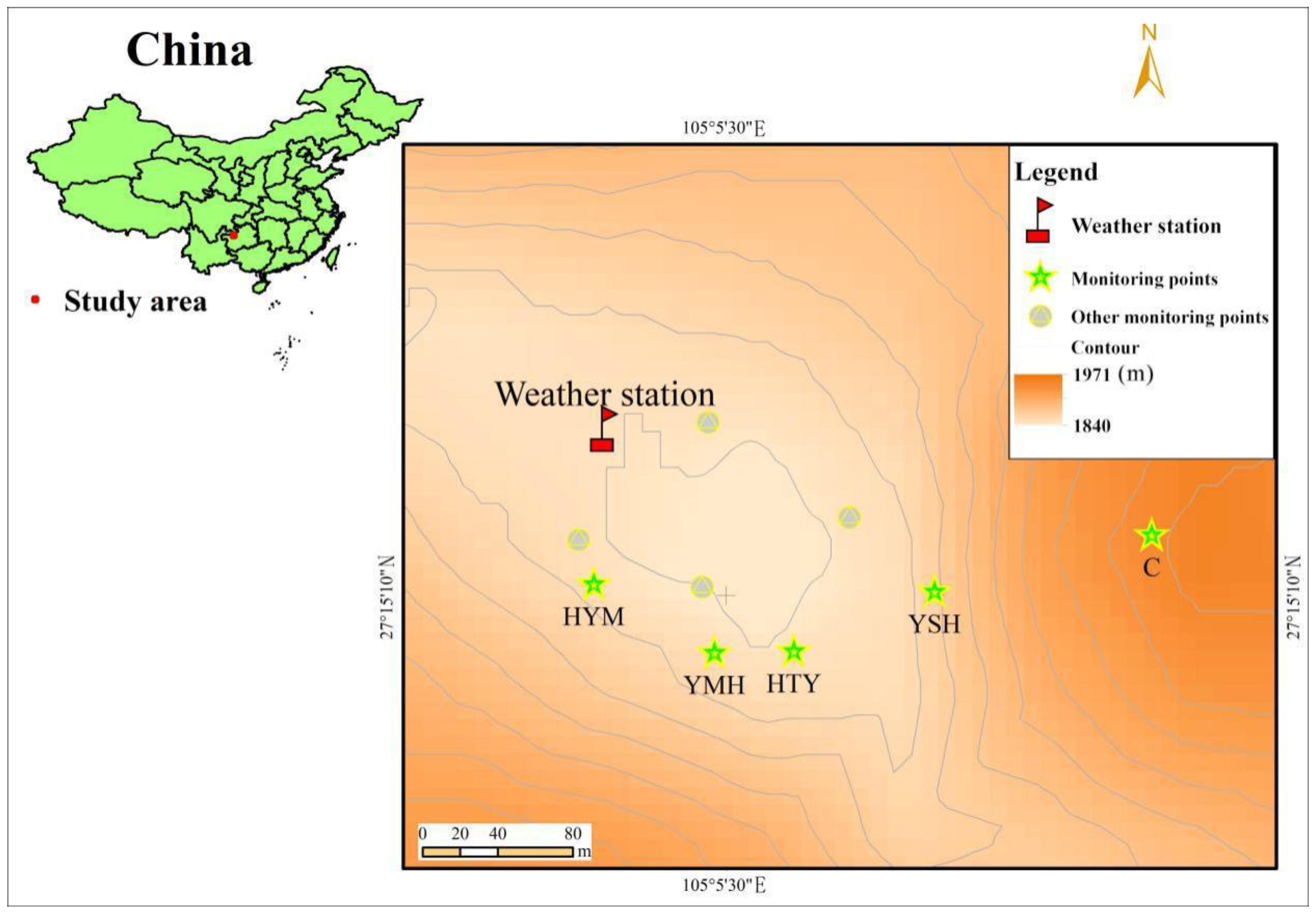
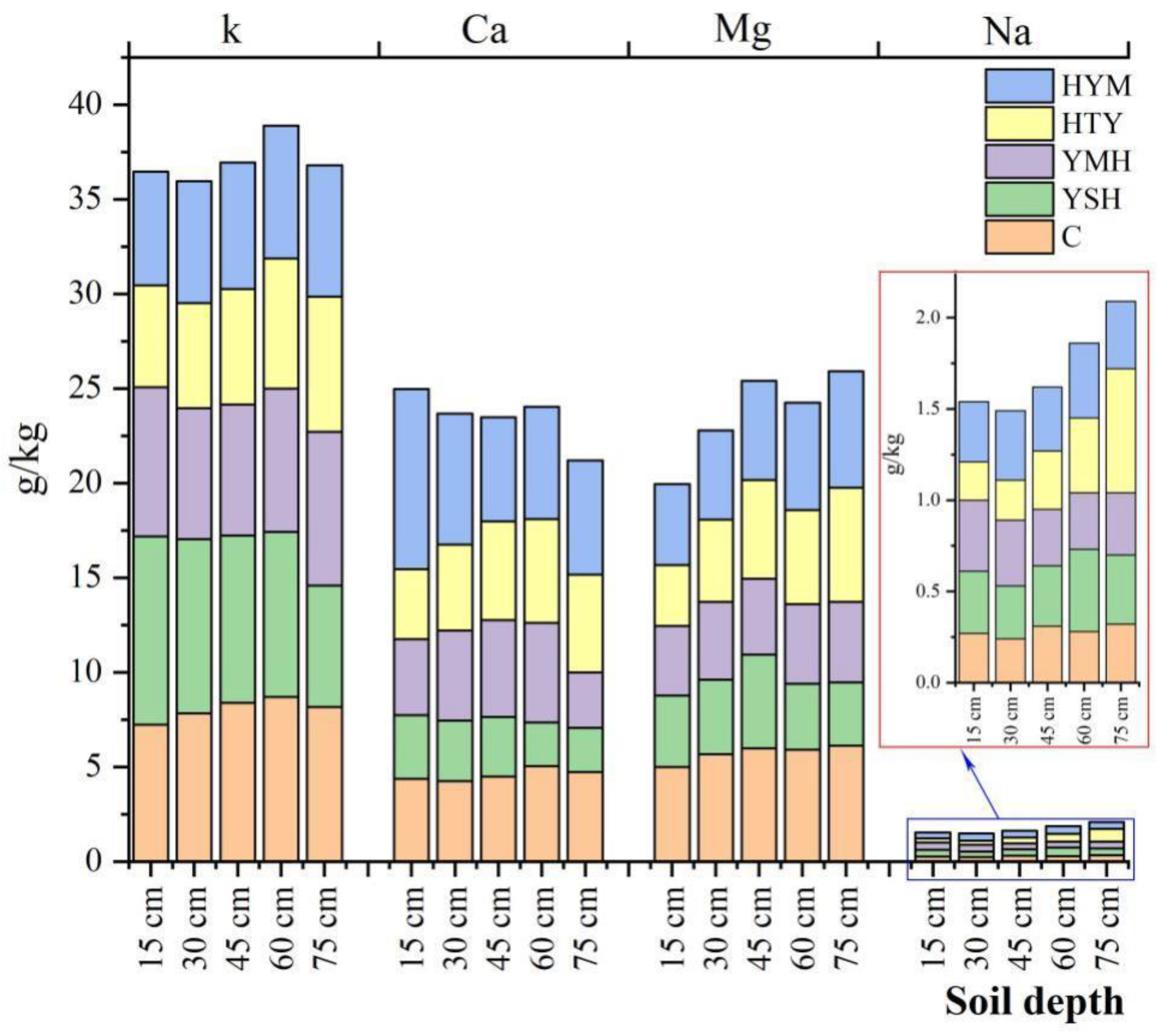

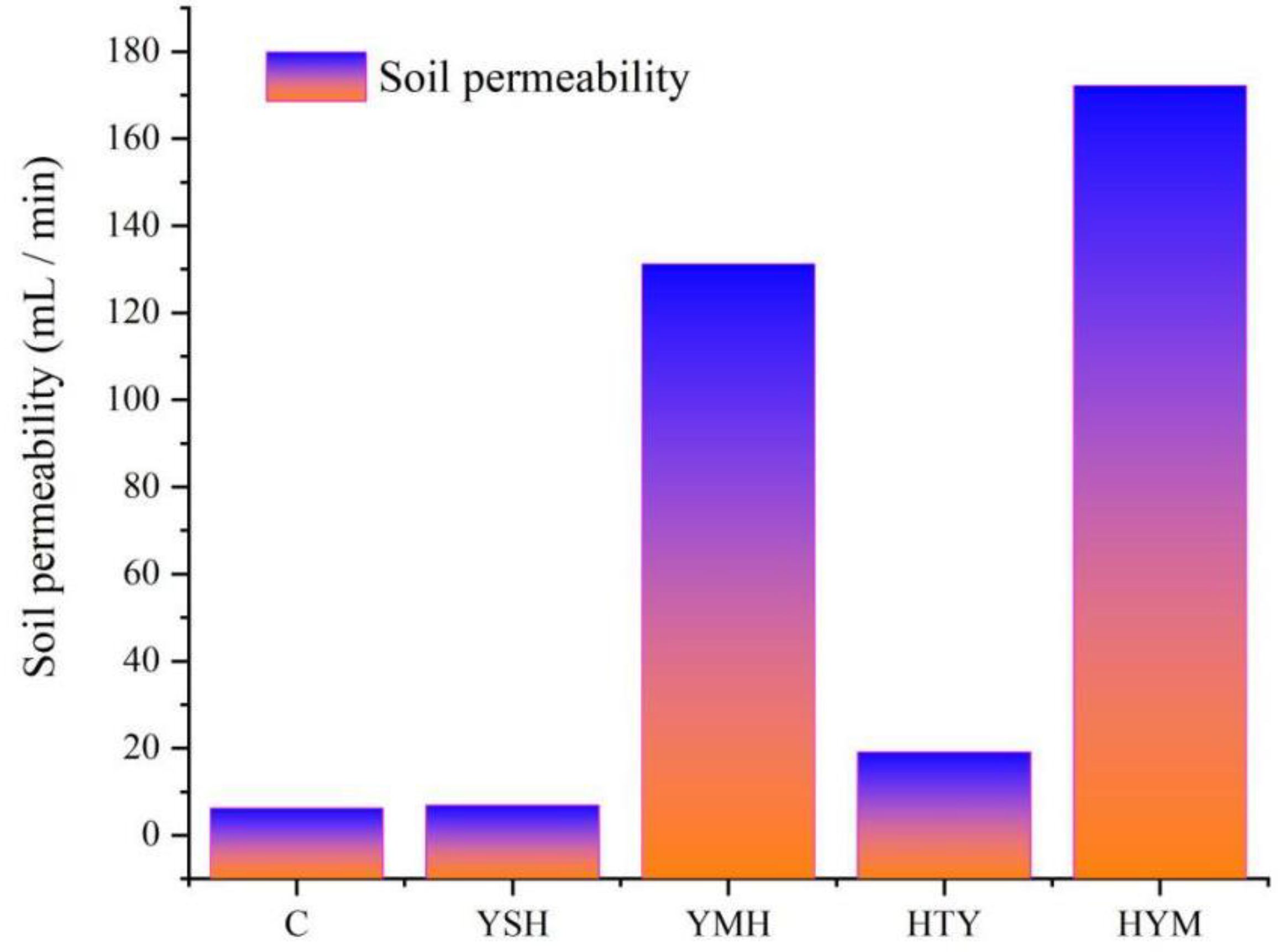
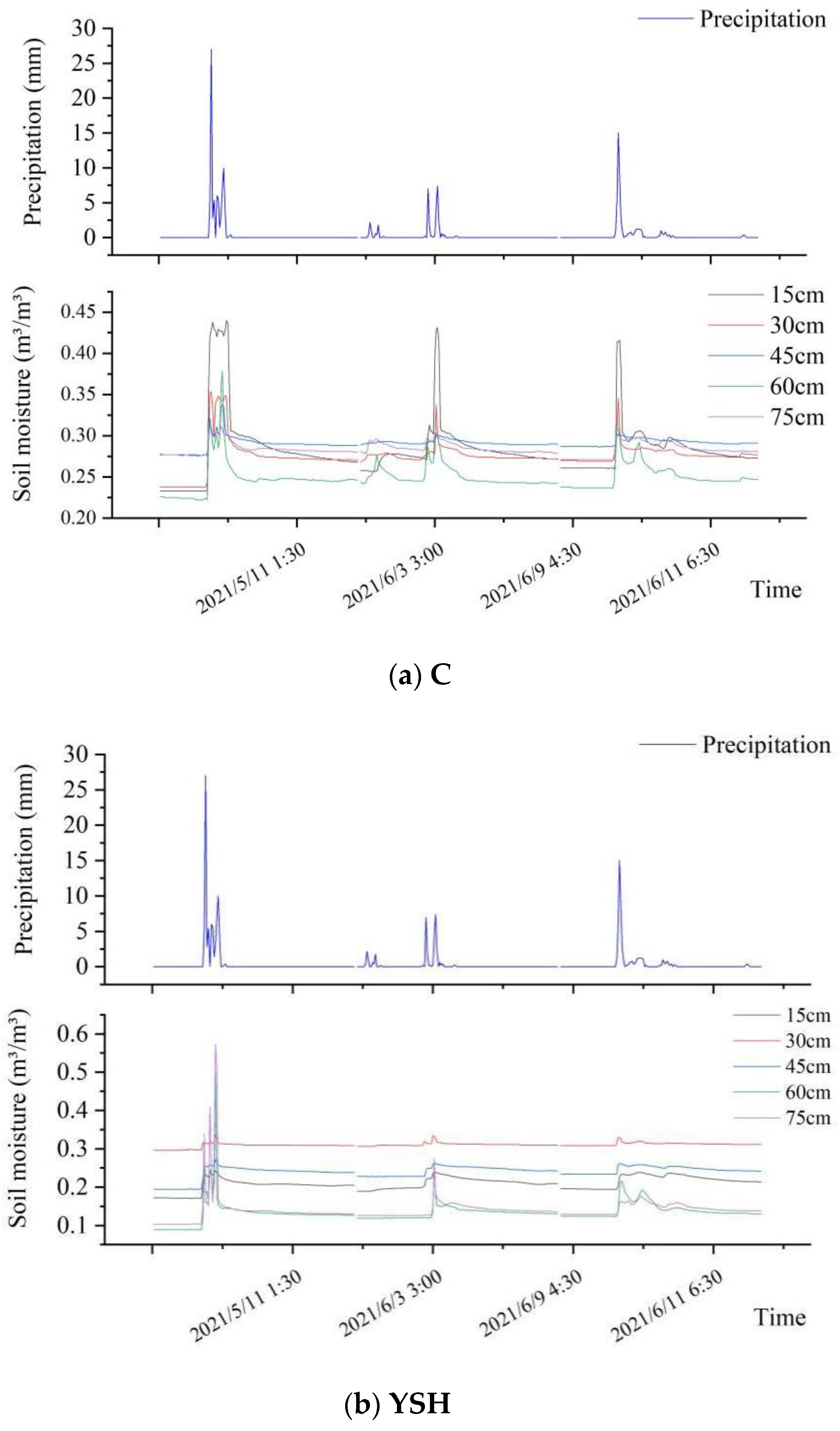
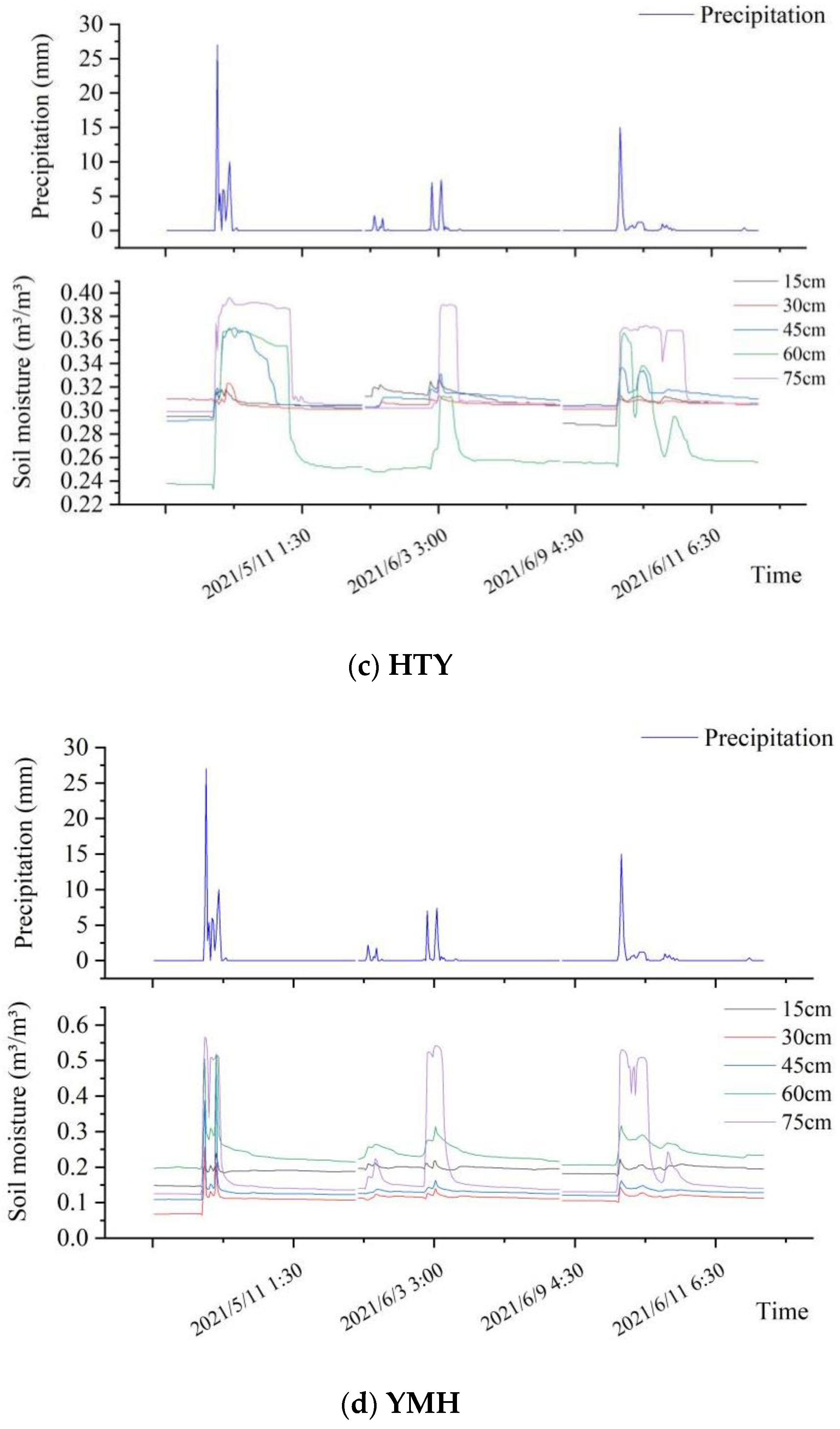
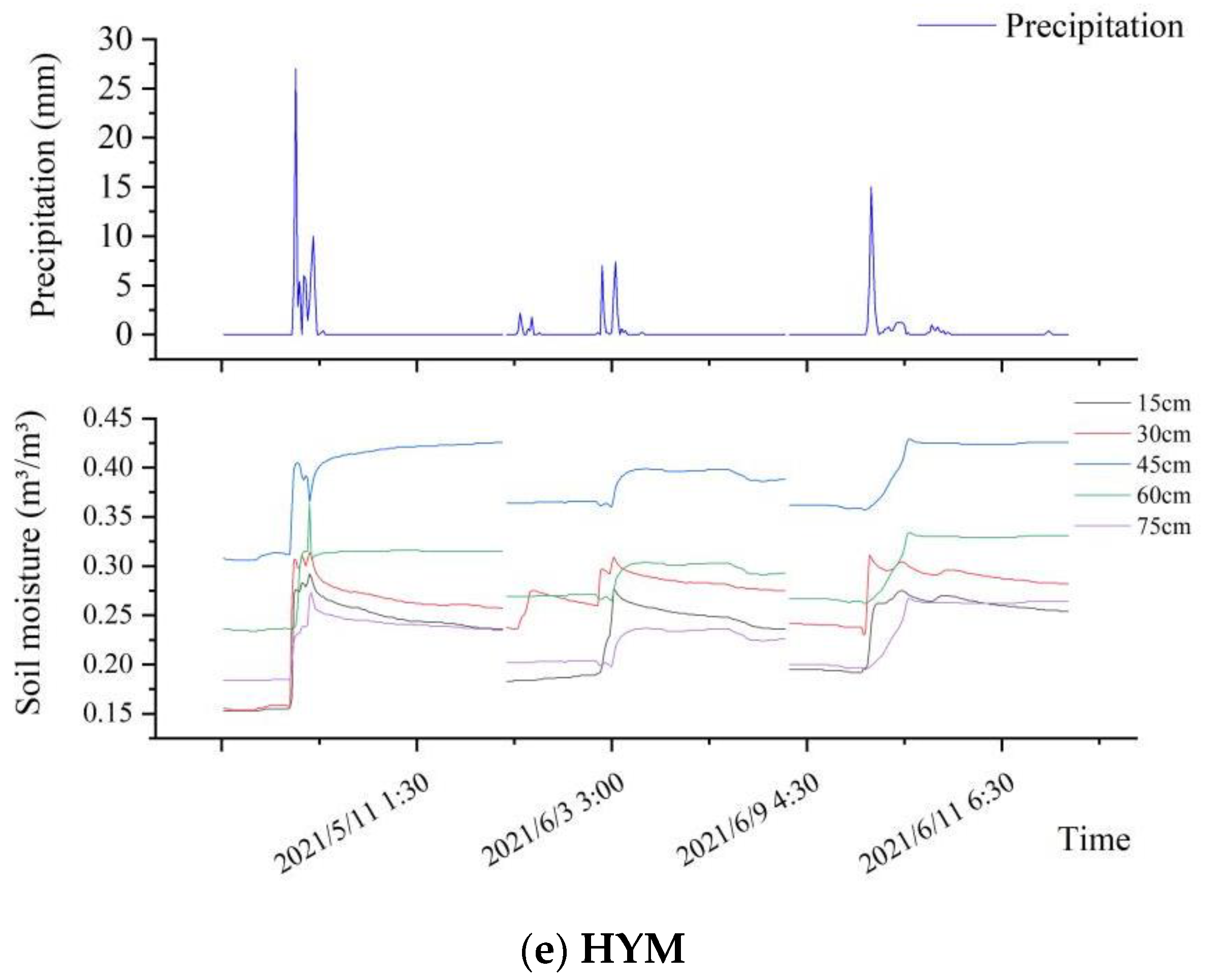
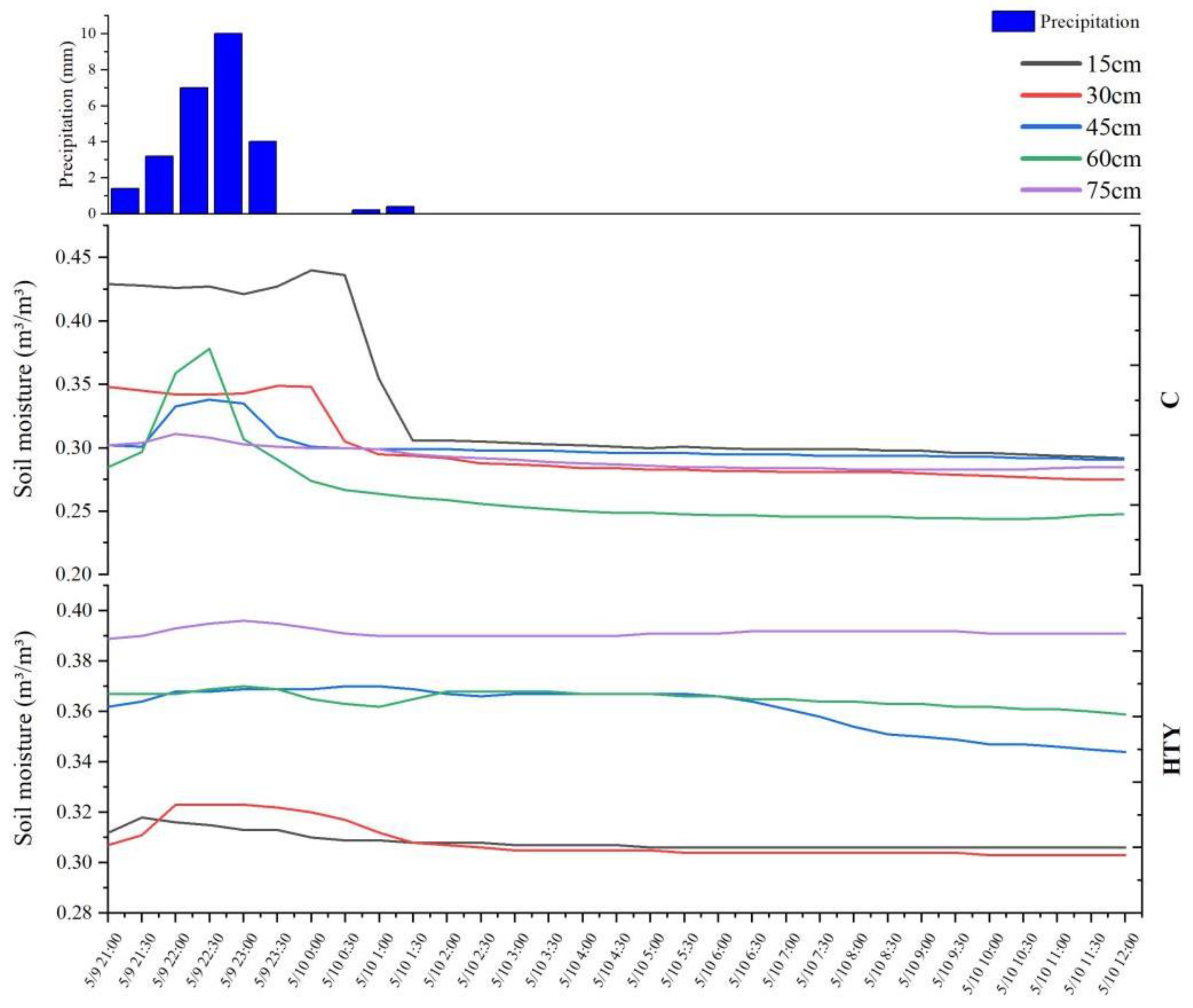
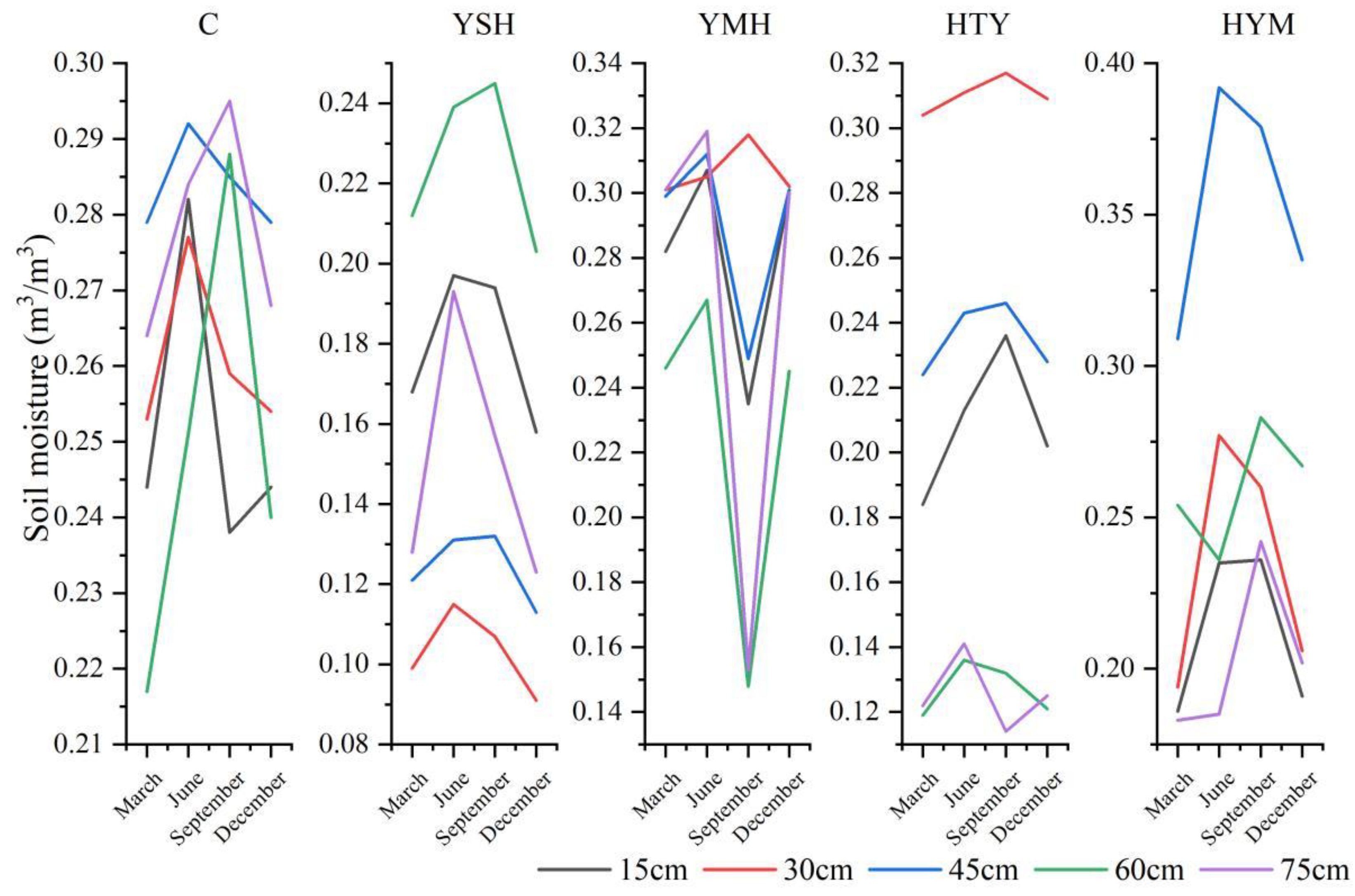
| Monitoring Points | Code | Longitude and Latitude | Type/Agroforestry |
|---|---|---|---|
| Control | C | 27°15′14″ N; 105°5′34″ E | Secondary forest |
| 1 | YSH | 27°15′9″ N; 105°5′31″ E | Poplar, Ryegrass |
| 2 | YMH | 27°15′9″ N; 105°5′30″ E | Corn, Ryegrass |
| 3 | HTY | 27°15′10″ N; 105°5′31″ E | Walnut, Corn |
| 4 | HYM | 27°15′12″ N; 105°5′29″ E | Walnut, Corn, Potato |
| Classification | K | Ca | Mg | Na | |
|---|---|---|---|---|---|
| Total description statistics | Mean value | 7.4012 | 4.6936 | 4.7316 | 0.3440 |
| Standard deviation | 1.1638 | 1.5330 | 0.9403 | 0.0913 | |
| Minimum | 5.39 | 2.32 | 3.21 | 0.21 | |
| Median | 7.15 | 4.73 | 4.71 | 0.33 | |
| Maximum | 9.95 | 9.52 | 6.15 | 0.68 | |
| C | Mean value | 8.06 | 4.574 | 5.734 | 0.284 |
| YSH | 8.636 | 2.876 | 3.902 | 0.358 | |
| YMH | 7.48 | 4.416 | 4.046 | 0.342 | |
| HTY | 6.218 | 4.822 | 4.762 | 0.368 | |
| HYM | 6.612 | 6.78 | 5.214 | 0.368 | |
| Pearson Correlation | Soil Moisture | Soil Porosity | Soil Permeability | Precipitation | |
|---|---|---|---|---|---|
| Soil moisture | Pearson | 1 | 0.36698 | −0.12335 | 0.422 |
| p | -- | 0.17845 | 0.66142 | 0.01 | |
| Soil porosity | Pearson | 0.36698 | 1 | 0.31054 | -- |
| p | 0.17845 | -- | 0.25995 | -- | |
| Soil permeability | Pearson | −0.12335 | 0.31054 | 1 | -- |
| p | 0.66142 | 0.25995 | -- | -- | |
| Precipitation | Pearson | 0.422 | -- | -- | 1 |
| p | 0.01 | -- | -- | -- | |
Disclaimer/Publisher’s Note: The statements, opinions and data contained in all publications are solely those of the individual author(s) and contributor(s) and not of MDPI and/or the editor(s). MDPI and/or the editor(s) disclaim responsibility for any injury to people or property resulting from any ideas, methods, instructions or products referred to in the content. |
© 2022 by the authors. Licensee MDPI, Basel, Switzerland. This article is an open access article distributed under the terms and conditions of the Creative Commons Attribution (CC BY) license (https://creativecommons.org/licenses/by/4.0/).
Share and Cite
Luo, D.; Xiong, K.; Wu, C.; Gu, X.; Wang, Z. Soil Moisture and Nutrient Changes of Agroforestry in Karst Plateau Mountain: A Monitoring Example. Agronomy 2023, 13, 94. https://doi.org/10.3390/agronomy13010094
Luo D, Xiong K, Wu C, Gu X, Wang Z. Soil Moisture and Nutrient Changes of Agroforestry in Karst Plateau Mountain: A Monitoring Example. Agronomy. 2023; 13(1):94. https://doi.org/10.3390/agronomy13010094
Chicago/Turabian StyleLuo, Ding, Kangning Xiong, Chenxu Wu, Xing Gu, and Zehui Wang. 2023. "Soil Moisture and Nutrient Changes of Agroforestry in Karst Plateau Mountain: A Monitoring Example" Agronomy 13, no. 1: 94. https://doi.org/10.3390/agronomy13010094
APA StyleLuo, D., Xiong, K., Wu, C., Gu, X., & Wang, Z. (2023). Soil Moisture and Nutrient Changes of Agroforestry in Karst Plateau Mountain: A Monitoring Example. Agronomy, 13(1), 94. https://doi.org/10.3390/agronomy13010094





